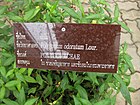Note: This is a project under development. The articles on this wiki are just being initiated and broadly incomplete. You can Help creating new pages.
Difference between revisions of "Persicaria odorata - Vietnamese Coriander"
(→References) |
(→External Links) |
||
| Line 85: | Line 85: | ||
==External Links== | ==External Links== | ||
| − | * [http://www.missouribotanicalgarden.org/PlantFinder/PlantFinderDetails.aspx?taxonid=293779&isprofile=0&] | + | * [http://www.missouribotanicalgarden.org/PlantFinder/PlantFinderDetails.aspx?taxonid=293779&isprofile=0& Persicaria odorata on missouribotanicalgarden] |
| − | * [https://davesgarden.com/guides/pf/go/310/#b] | + | * [https://davesgarden.com/guides/pf/go/310/#b Persicaria odorata on on daves garden] |
| − | * [http://www.herbcottage.com.au/vietnamese-mint.html] | + | * [http://www.herbcottage.com.au/vietnamese-mint.html Persicaria odorata on mudbrick cotage herb farm] |
| − | * [https://www.daleysfruit.com.au/Vietnamese-Mint- | + | * [https://www.daleysfruit.com.au/Vietnamese-Mint-Persi caria-odorata.htm Plant Information or Specifications of Persicaria odorata] |
[[Category:Herbs]] | [[Category:Herbs]] | ||
Revision as of 14:12, 4 May 2018
Persicaria odorata is an herb whose leaves are used in Southeast Asian cooking. Other English names for the herb include Vietnamese mint, Vietnamese cilantro, Cambodian mint, hot mint, laksa leaf, and praew leaf. Its Vietnamese name is rau răm, while in Indonesia, Malaysia, and Singapore it is called daun kesum, daun kesom, or daun laksa. In Thailand, it is called phak phai and the Hmong word for it is luam laws. In Laos, it is called phak phaew, and in Cambodia chi krasang tomhom or chi pong tea koun. In North-East India, Manipur state uses this as garnishing herb over various cuisines such as Eromba and Singju. Manipuris called it as phak-phai.
Contents
Uses
fever, ringworm, vomiting, phagedaena, skin problems, acne, reduce nausea, aid digestion.
Parts Used
Chemical Composition
In the essential oil of Vietnamese coriander, long-chain aldehydes were found, e. g., decanal (28%) and dodecanal (44%), furthermore decanol (11%). Sesquiterpenes (α-humulene, β-caryophyllene) account for about 15% of the essential oil.[1]
Common names
| Language | Common name |
|---|---|
| Kannada | |
| Hindi | |
| Malayalam | |
| Tamil | |
| Telugu | |
| Marathi | NA |
| Gujarathi | NA |
| Punjabi | NA |
| Kashmiri | NA |
| Sanskrit | |
| English | Agrimony |
Habit
Identification
Leaf
| Kind | Shape | Feature |
|---|---|---|
| Simple | Alternate | Foliar Attachment to Stem is Petiolate and Foliar Shape(s) is Ovate. |
Flower
| Type | Size | Color and composition | Stamen | More information |
|---|---|---|---|---|
| Bisexual | 2-4cm long | Pink, Purple, White | 5-20 | Flower Grouping is Cluster / Inflorescence and Flowering Habit is Polycarpic |
Fruit
| Type | Size | Mass | Appearance | Seeds | More information |
|---|---|---|---|---|---|
| simple | Fruit Type is Indehiscent Dry Fruit (Nut / Nutlet) | Mature Fruit Colour(s) [Angiosperms & Gymnosperms] is Brown | {{{6}}} |
Other features
List of Ayurvedic medicine in which the herb is used
- Vishatinduka Taila as root juice extract
Where to get the saplings
Mode of Propagation
How to plant/cultivate
Succeeds in tropical to warm temperate areas[3]
Commonly seen growing in areas
Terrestrial, Tropical, Sub-Tropical, Monsoonal
Photo Gallery
References
External Links
- Pages that are stubs
- Ayurvedic Herbs known to be helpful to treat fever
- Ayurvedic Herbs known to be helpful to treat ringworm
- Ayurvedic Herbs known to be helpful to treat vomiting
- Ayurvedic Herbs known to be helpful to treat phagedaena
- Ayurvedic Herbs known to be helpful to treat skin problems
- Ayurvedic Herbs known to be helpful to treat acne
- Ayurvedic Herbs known to be helpful to treat reduce nausea
- Ayurvedic Herbs known to be helpful to treat aid digestion
- Herbs with Leaves used in medicine
- Herbs with common name in English
- Habit - Perennial
- Index of Plants which can be propagated by Seeds
- Index of Plants which can be propagated by Cuttings
- Herbs that are commonly seen in the region of Terrestrial
- Herbs that are commonly seen in the region of Tropical
- Herbs that are commonly seen in the region of Sub-Tropical
- Herbs that are commonly seen in the region of Monsoonal
- Herbs








